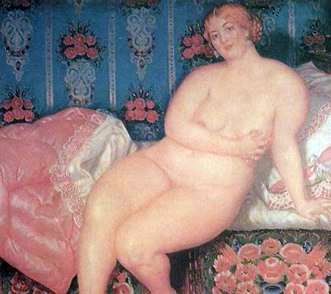
The artistic direction to which Kustodiev belonged in the 1910s can be called “neoclassicism”. It assumed an orientation to the great models of the past – taking into account the latest artistic trends.
This is a kind of “passéism” – both in the formal and in the content area – but transformed by obvious grotesque and indispensable irony. “Looking at” the past – in this case – was motivated by two more things.
The first motivation is the painful illness of the artist, which deprived him of his “external” impressions. He had to live in the world of fantasy, one of the “core” images of which this “beauty” is. The second is a war that destroyed a single artistic space. The painters were cut off from each other, and therefore an appeal to the old masters in these conditions looked like a “conceptual” act. By the way, “Beauty” was a favorite picture of A. M. Gorky, who received one of her versions as a gift from the artist’s hands.
Merchants and beauties are Kustodiev’s know-how. They demonstrate the mature style of the master, while at the same time being a visible expression of his ideas about human beauty. Yes, this expression is somewhat cartoonized, but such irony often serves only as a means of protection from too “refined” criticism. Hence, there is also some epatage, with which Kustodiev presents his heroine, placing her in the center of the canvas and bringing it to the fore.
The harmonious context formed by the colorful interior is uniquely dictated by its image. The whole picture is a dream of beauty, which is – how to know? – suddenly it will save the world. This is a dream, this is a dream. This is a dream about an unprecedented Russia. Kustodiyev saw it in his soul, tied to the middle of the XIX century, to some “unfamiliar city”, and made his contemporaries and descendants fall in love with this image, full of healthy strength, stature and grace. “Estets” grin: “Well, is it really a beauty?” “Aesthetics” is always very narrow.
In fact, beauty is different. The ideal of beauty is mobile and varies with geography, epoch, social conditions of life. The beauty of antique statues argues with the beauty of Byzantine art, and the glorification in art of Gothic of mortified flesh contradicts the Renaissance cult of poeticized sensuality. Kustodiev has his ideal. And he is really perfect, otherwise several generations of art lovers would not care about their strange grace.
 Tradeswoman for tea by Boris Kustodiev
Tradeswoman for tea by Boris Kustodiev Beauté – Boris Kustodiev
Beauté – Boris Kustodiev Horses during a thunderstorm by Boris Kustodiev
Horses during a thunderstorm by Boris Kustodiev Children by Boris Kustodiev
Children by Boris Kustodiev Autumn in the province. Tea drinking by Boris Kustodiev
Autumn in the province. Tea drinking by Boris Kustodiev Spring by Boris Kustodiev
Spring by Boris Kustodiev Russian Venus by Boris Kustodiev
Russian Venus by Boris Kustodiev Lilac by Boris Kustodiev
Lilac by Boris Kustodiev